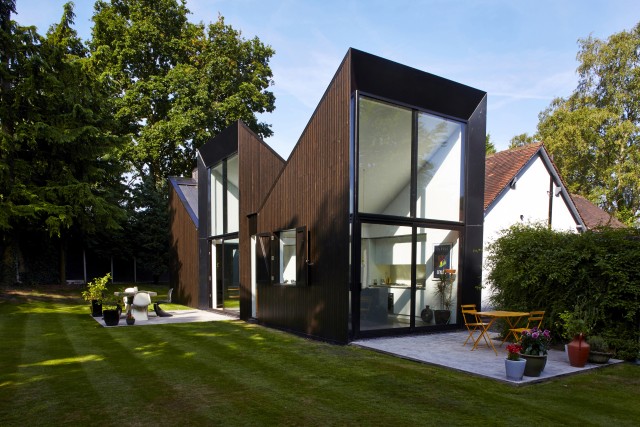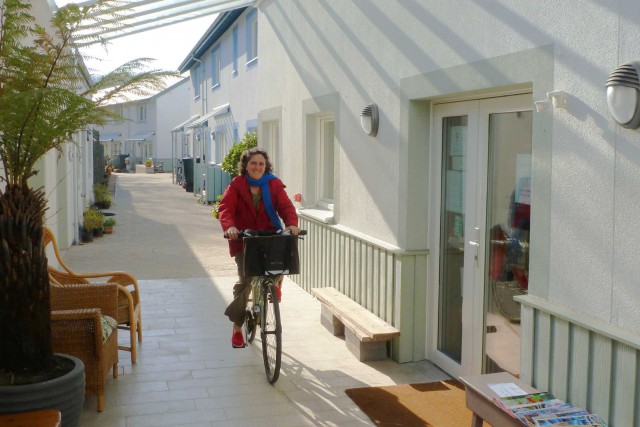The Big Interview: Andrew Ruffler
Ahead of the Royal Institute of British Architects (RIBA) North West Awards, we quizzed Regional Director Andrew Ruffler on the quality of north-west architecture, what healthy cities should look like and the future of UK design…
The Double Negative: The RIBA North West Awards Shortlist for 2014 has just been announced – tell us more about that.
Andrew Ruffler: We had 33 entries in total in the north-west; we then had to assess who were the strongest to make the shortlist of 12. Nine architects and one non-architect put themselves forward to judge and are often previous award winners. They have to have no projects in this year’s list, to avoid conflicts of interest. They basically access each scheme on its own merits.
In terms of the Awards event itself, we’re going to have a big party this year (anyone can come!) at Oh Me Oh My. I wanted to get away from the black tie, stuffy dinners we usually have, because everybody does them, and it tends to be the same people who attend – directors, heads of practices, but not the people on the ground who are actually doing the work. I want to do a bit more of a celebration, have a few drinks, with a new audience, that is more relaxed – a real celebration of north-west architecture.
The process is really interesting – you always find a hidden gem. You may know about the new Everyman or Central Library, but it’s the private house in Chorlton or Cumbria that you don’t know. I think the panellists get surprised as well.
What is the purpose of the RIBA?
Everything we do is about raising the awareness of architecture, good design and our members; in the awards, for instance, we’re trying to showcase of best examples of good design that year, and at the same time raise the standards. Even those who may be disappointed at not being chosen, you would hope they’d take something away from the process, and to be able to say, ‘How can I get shortlisted next year?’ Some kind of self-criticism. For us it’s always about trying to push, push, push the quality of design.
With our recent City Health Check Report, we’re trying to say that there’s a direct link between the spaces around the city – green spaces, walkways, streets – and the way people exercise and keep healthy. If councils around the country want their town to be healthy, then they’ve got to allow some flexibility when allowing planning approval. So when they’re looking at schemes, to be able to say, ‘Well there’s not enough green space here, or do we take it to the design review or Places Matter for an impartial analysis?’
On that recent City Health Check; Birmingham and Liverpool were shamed as the unhealthiest in the UK. Why?
The assessment looked at all the core cities around the UK. Liverpool has the highest levels of obesity amongst children, and Birmingham has the highest number of adult cases of diabetes. The conclusion that we’re trying to get across is that this can be influenced by better design and better planning, and through special awareness and management. Again, it’s just trying to raise design higher up the agenda, so it’s critical to the future of our cities.
Realistically, how much do architects consider health when designing?
I wouldn’t see this report as something our members would use directly. I’d see this something coming more the other way; an understanding of local authorities and planners to ask architects whether they are considering having more trees, green space and cycle paths e.t.c., because we’ve raised some awareness of the potential issues — push and pull. When architects are designing schemes, they do tend have a holistic approach; they’ll be trying to provide the best solution for that space.
What city comes out on top in the report?
I think Bristol comes out well, on a number of factors; interestingly enough, the new mayor of Bristol, George Ferguson, is an architect! London came out low on a lot of things.
It’s interesting considering the recent (massive) Liverpool City Council funding cuts; there’s a £156m shortfall, and green spaces will surely be affected in our near future. If there’s no money, how can we change our label of unhealthiest city? How does RIBA fit into this?
This is a national report; it comes down to us then in the regions to make connections with the local authorities to have some impact on a local level. Our RIBA North West team is small; we’re then relying on our members, especially our most enthusiastic ones, to use this report as an influencing piece, when talking to planners, leaders. It’s quite a soft approach but somehow we have to use the tools at our disposal to get out there and spread the message.
This is just one of three reports released over the last six months. One was called Silver Linings, on how people over 60 are influencing our cities, and Designing With Data, looking at the digital future of the city.

How behind are we in the UK to the rest of the world?
Copenhagen is always trotted out as a good example in terms of their standard of living, with impressive cycling initiatives and things like that. I think solutions are relatively simple to implement, but just need the drive of the people in charge.
And being imaginative with smaller budgets too we expect. This is a concern though isn’t it; we’re suffering under austerity, but cities still need to change. How are we going to be clever about that?
Well, it’s good for me that this is on the agenda in the north-west. If you look at the International Festival of Business 2014 programme, it’s full of small to large events on regeneration; the debate is taking place, it’s important now to move on to implement change. There was a great debate last month in Chester with the Cheshire Society and the Civic Trust on design in a historic setting; we had Stephen Hodder, RIBA President, Council Leader Mike Jones, and various councillors, architects and developers. The discussion was on how design can be put at the forefront.
Chester is currently bidding to become the UK City of Culture 2017, yet the Council Leader has expressed concerns that the city is thought of as a living museum. How do you think they can move on?
They’re kickstarting all this at the moment. There is a new theatre and library plan on the old cinema site. Even that has come up against a lot of public opposition, however. That’s where it comes back to us; trying to get the right messages across, listening to the public, getting impartial design reviews, presenting the schemes.
The key thing is getting the political leaders and design leaders together to understand each other for some agreement to be made. At this debate, we wanted to get the leaders to agree to an independent design review process; Chester have been a bit reticent about it for whatever reason, so we’re working on that.
What does a design review entail?
So a panel of say four people, chosen completely independently of the project, sat down, critically reviewing the proposal. The architect would come in and present a solution, in this case the new theatre, and the panel would talk through it and prose different solutions. The Places Matter service has a panel of around 50 people who are planners, architects, highway engineers, structural engineers, artists… you name it, people who have an understanding of that field. And it works incredibly well. There are so many award-winning buildings that have been through this process. That’s when things get tested and you hopefully don’t end up with too many bad buildings.
Don’t all architects have to use an impartial review process?
Some don’t feel the need. Some developers don’t want to use it in case it impacts on the returns – for instance, if the review recommended less units in a housing scheme. There’s some pull back. Others really go for it because they recognise the benefits. It’s not universally taken up, as we feel it should be. The more local authoritites that include it in their planning guides, the better. The ideal for us is that it would be compulsory.
You work with a lot of young people through projects like Forgotten Spaces and Northern Soul. Where do you think RIBA’s place is within architecture schools in the UK? Do you feel you can make an impact on future designers?
We need to do more with students. We need to find the right way of doing it. I’m not sure from a north-west perspective that we’ve got the right answer yet. Students of architecture tend to get a lot of what they need within university, so they don’t currently feel the need to break free and engage with a professional body and do extra projects. Last year’s Northern Soul design charrette helped to do that. A big part of the future of studying architecture is going to be engaging with practice; we need to facilitate that. How we can link schools with industry and vice versa. We’re just about to invite a student to sit on our regional council, so a very formal link, but I do think we need to do more to engage with the wider student body.
We need to find a way for a student, starting first year right up until they leave, to feel that RIBA is with them on the journey with support. It could be a case of working just a lot more closely with the schools – two in Liverpool, one in Manchester, one in Preston and potentially one in Salford – and doing things together.
What are your views on contemporary architecture in the north-west?
It’s great! The best contemporary architecture tends to have gone through a process of design review, and a lot of it gets recognised through the Awards process. What I would like to see is more and more regional practices being commissioned, first and foremost, and then winning awards. There’s still, in both major cities, projects being awarded to national and international firms; we need to find a way – whether it’s smaller practices working collaboratively – for regional practices and RIBA members to start winning these schemes.
I’d love, for instance, for the new Everyman to have been designed by a Liverpool practice. You get a great building, of course, but you also want that regional element. It was the same doing the award shortlisting; you see a lot of the firms listed as London, London, London. It’d be nice to see Liverpool, Manchester, Preston. There’s a bit of bravery required from the people commissioning and procuring these buildings.
What is RIBA doing this summer in Liverpool during the major IFB, Biennial and Designival events?
The aim is to take the three recent RIBA reports to IFB2014 and host a number of key events. Big name speakers talking about best practice; engaging the city’s leaders and getting a bit of a debate going. We’re also talking to UK Trade & Investment (UKTI) about an exciting project linking up Bristol, Liverpool and either NY, Boston or Chicago; a transatlantic event, perhaps a design competition across the three international cities promoting collaboration. We’re also excited about Mondrian at Tate Liverpool.
Laura Robertson
The 2014 RIBA North West Awards will be presented by BBC One Show presenter and comedian Alex Riley at Oh Me Oh My, Liverpool, this Thursday 17 April 2014, 7-11pm (£7.50/10) – see here for tickets
More on RIBA North West and on the 12 buildings selected for the RIBA North West Awards
Image credits:
Triptych, Manchester – Blee Halligan Architects (c) MikeBlack
Manchester School of Art – Feilden Clegg Bradley Studios (c) Hufton and Crow
Lancaster Cohousing – Eco Arc Architects (c) Luke Mills
Carmelite Monastery, Liverpool – Austin-Smith:Lord LLP (c) SG Photography









